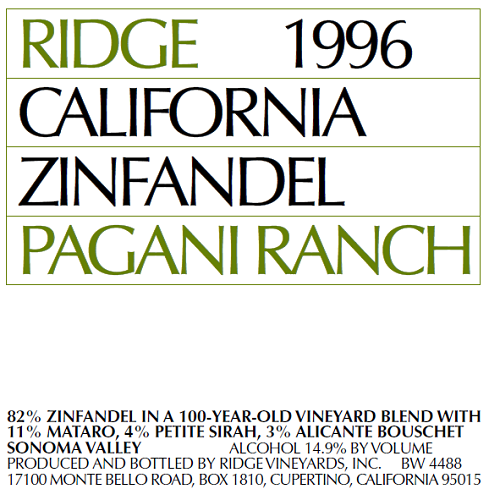
1996 Pagani Ranch Zinfandel
Wine Information
82% Zinfandel, 11% Mataro, 4% Petite Sirah, 3% Alicante Bouschet
Vintage
1996
Vineyard
Pagani Ranch
Appellation
Sonoma Valley
Alcohol By Volume
14.9%
Vintage Notes
These old, low-yielding vines have a tendency to ripen very fully—the ’92 and ’95 vintages were designated “late picked”. With its exceptionally warm weather, 1996 might have been expected to follow suit. The ripe berry and dense structure are present; it is their beautiful balance that makes this the loveliest, most elegant Pagani to date. Somewhat unusual is the use of only five percent new oak and no one-year-old oak in barrel aging. The purity of complex fruit carries the wine. As with most fine zinfandels, this fruit will be most appealing during the first five years.
History
This is the sixth vintage in which we have made zinfandel from the very old Pagani vineyard on the east-facing side of Sonoma Valley. The oldest vines were planted more than one hundred years ago, the youngest about eighty years ago. Primarily zinfandel, with some interplanted petite sirah vines, the vineyard also includes several small blocks of alicante and about six acres of mataro (mourvèdre).
Pagani Ranch exemplifies what we look for in a zinfandel vineyard: old vines, carefully tended by a quality conscious family who—in this case—have worked the land for three generations. The single most convincing proof of this vineyard’s merit is the fact that it has survived so long. An average site would have been abandoned during the thirteen years of Prohibition, or during the Depression. This is an unusual vineyard, and a fine one. Since his boyhood, nonagenarian Louis Pagani has cared for these vines as though they were his children. He is keenly conscious of the quality his ranch produces, and determined to maintain it.
To avoid the spring frosts of this cool region, the vines are pruned late. This delays bud break, and there is less chance of frost as spring advances. On the negative side, the growing season is moved back. All our other zinfandels are harvested in September or early October, but Pagani ripens a full three weeks later. This is wine-growing “on the edge”.
Growing Season
In 1996 an unseasonable series of storms in early spring did not affect the vines at Pagani Ranch—the flowers had not yet emerged, therefore the typically small crop was not reduced further. We worried that the late development would delay harvest until very late fall, but luck was with us. Extremely warm summer temperatures pushed the zinfandel to ripen ahead of its normal schedule. The eighty-year-old alicante set an unusually big crop—still only three and a half tons per acre—and we waited until the last days of October for it to ripen completely. The day after these last vines were picked, the rains came—yet another fortunate year for us and Pagani Ranch.
Winemaking
Fermented, on average, for about eight days in small tanks, the ripe zinfandel showed lovely, balanced fruit even in the fermentor. About sixty percent was fermented using the submerged cap approach. In the remaining lots, the skins were allowed to float, the juice gently pumped over to extract color and body. After malolactic fermentation, the wines were racked to air dried american oak for aging. Only five percent new oak, and no one-year old oak was included.
Consumer Tasting Notes
Average Rating: 88.2
No. of Tasting Notes: 20
View this wine on CellarTracker
Marketing Materials
POS Materials
Food Pairings
See all food pairing recipes we have created specifically for this wine.
See pairingsWait!
In order to qualify for user related discounts, you must log in before proceeding with checkout. Click the button below to log in and receive these benefits, or close the window to continue.
Log In